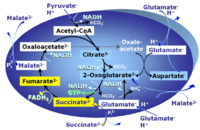Difference between revisions of "PGMS-pathway control state"
From Bioblast
Beno Marija (talk | contribs) |
|||
| Line 10: | Line 10: | ||
{{MitoPedia concepts | {{MitoPedia concepts | ||
|mitopedia concept=Respiratory state, SUIT state | |mitopedia concept=Respiratory state, SUIT state | ||
}} | |||
{{MitoPedia topics | |||
|mitopedia topic=EAGLE | |||
}} | }} | ||
== PGMS(L) == | == PGMS(L) == | ||
Revision as of 14:48, 18 November 2016
Description
PGMS: Pyruvate & Glutamate & Malate & Succinate.
MitoPathway control state: NS
2-oxoglutarate is produced through the citric acid cycle from citrate by isocitrate dehydrogenase, from oxaloacetate and glutamate by the transaminase, and from glutamate by the glutamate dehydrogenase. If the 2-oxoglutarate carrier does not outcompete these sources of 2-oxoglutarate, then the TCA cycle operates in full circle with external pyruvate&malate&glutamate&succinate
Abbreviation: PGMS
Reference: Gnaiger 2014 MitoPathways - Chapter 5.6
MitoPedia concepts:
Respiratory state,
SUIT state
MitoPedia topics:
EAGLE
PGMS(L)
PGMS(P)
PGMS(E)
Discussion
- Recent studies showed that S- and NS-linked OXPHOS capacity is inhibited by 2 mM malate concentrations as applied in many SUIT protocols. This inhibition is less pronounced at higher succinate concentrations (10 mM up to 50 mM S).

